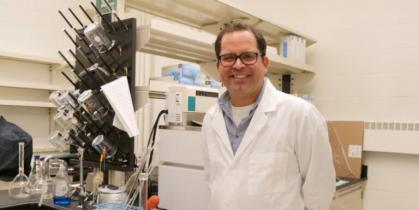Research Underway to Develop Lightweight Eco-Manufacturing and Construction Components

In David Salas-de la Cruz’s Rutgers University‒Camden lab, researchers are developing sustainable, adaptive building blocks using natural substances from plants and animals, along with synthetic polymers, that could replace common construction materials such as wood, concrete, and steel.
A durable, lightweight, natural-based plastic material that the team is producing with sugars and softeners can be folded and formed for architectural and manufacturing use. These materials can be recycled, regenerated, reused, and repurposed.
As a roofing material, a section of the roof could automatically change its color from black to white in order to change the reflection of light, reducing the absorption of heat to cool the house during a heat wave.
To reduce the effects of noise from outdoors or an adjoining room, a section of a wall could form a new shape that looks like a soundproof acoustic studio, which would prevent noise from coming into the room.
“By exchanging the properties of the material, we can create materials that could be used as insulators to eliminate noise from the room or it could be used to build new geometrical designs in the construction of buildings or houses,” says Salas-de la Cruz, an associate professor and graduate program director of chemistry at Rutgers University–Camden.
Plastic made from natural materials can be folded when exposed to water. The material could be used for insulation in buildings.
Using engineering inspired by origami, the Japanese art of paper folding, and kirigami, which involves folding and cutting, this new plastic composite material could be used to create unique geometrical structures.
Making folds on a flat sheet of the material, incorporating cuts, and adding heat or water will allow the material to form into a desired structure. “But instead of you doing it yourself by hand,” says Salas-de la Cruz, “imagine now, the sheet forms by itself. If you change the properties of the material, now you have something that could twist, but in another section of the material where it twists, it can also turn to create 3D structures.”
Another possible application for this material is for rapid robotic assembly. The material could be used as the skin of the robot where it can sense touch and temperature, or it could be used to integrate circuits within the material to create artificial muscles. “It can behave very much like human skin,” Salas-de la Cruz explains.
A collaborative five-year National Science Foundation-sponsored project, the research involves a multidisciplinary research team from the University of Pennsylvania, Princeton University, Rowan University, and Rutgers‒Camden.
The project offers Rutgers‒Camden students access to specialized equipment on all of the campuses and allows collaboration with experts in architectural and structural designs, chemistry, physics, materials science, biochemical and mechanical engineering, computation, and economics.
“It is really cool being exposed to all of this, especially as chemists,” says Creston Singer of Fairfax, Va., a student in the Rutgers University‒Camden Center for Computational and Integrative Biology Ph.D. program. “When we talk with our own people, we have to talk in our own chemistry language. When we talk to someone at the University of Pennsylvania architecture group, it is definitely a different language, but it is very interesting to see what they add to the materials that we are trying to make.”
“Everyone is willing to help out,” says Abby Morales, of Camden, a CCIB Ph.D. student and a 2020 Rutgers‒Camden graduate. “People say, ‘What did you find? Do you need help?’ It is very hands-on. Sometimes we have to do analysis by ourselves, but we can always reach each other through messaging and say, ‘Hey, I need a second eye to look at this.’”
“The construction business has not changed in many years in terms of materials,” says Salas-de la Cruz. “It is not sustainable at all. They produce a lot of carbon dioxide and waste. It is detrimental to nature. You have to break mountains in order to extract the material that’s required to make cement. We are hoping that by creating new materials, maybe we can push the construction business into a new era.”



